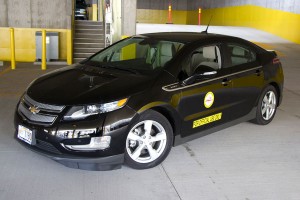New Transportation Strategy Outlines Transition to EVs

Hawai‘i County was among the purchasers of alternative fuel cars this year. Shown is a 2012 Chevy Volt, one of five electric hybrid vehicles to be added to county’s fleet. File photo.
The Hawaiian Electric Companies (HECO) have announced a new strategy to reduce energy dependence on fossil fuels for energy, and actions to create more clean energy alternatives in Hawai‘i.
Called the Electrification of Transportation Strategic Roadmap, the plan was filed with the Public Utilities Commission and aims to power most personal vehicles with renewable resources by 2045.
According to HECO, Hawaiʽi currently has the second highest rate of electric vehicle adoption in the U.S. The plan includes global vehicle manufacturer plans to introduce dozens of all-electric models with extended battery range over the next decade.
“This is a global movement that is transforming the way that individuals, families and businesses use vehicles and we have to be ready,” said Brennon Morioka, Hawaiian Electric’s general manager of electrification of transportation. “This roadmap lays out the steps for meeting the changing needs of our customers and communities and adapting to the new technologies we know are coming.”
According to the plan, charging cars, trucks, buses and heavy equipment in the coming years is expected to make room on the grid for nearly 200,000 more private rooftop solar systems and many grid-scale renewable projects. HECO said using the electric grid to charge vehicles and equipment as power generation transitions toward 100 percent renewables can lower the cost of electricity to utilities customers, benefit the state economy and help integrate more renewable energy resources.
“Hawaiian Electric first promoted electric vehicles more than 100 years ago,” Morioka said. “Today, the urgency has never been greater to reduce our use of oil for moving people and goods on the way to our clean energy future. This roadmap will guide our actions. The timing and precise route may change, but our destination and determination to reach it are clear.”
Hawaiʻi currently has some 7,000 registered EVs, second only to California per capita. In addition to rail, which will be powered by electricity, the City and County of Honolulu is considering electric buses to replace its diesel fleet.
The plan outlines the following key near-term steps:
- Boost EV adoption by working with automakers, dealerships and advocates to lower the purchase price and educate customers on vehicle options and benefits;
- Partner with third-party charging providers and others to facilitate the buildout of charging infrastructure, especially in workplaces and multi-unit dwellings. Expand the network of utility-owned fast-chargers and public Level 2 chargers in gap areas to reduce range anxiety;
- Support customers to transition to electric buses with targeted efforts to reduce the upfront cost and provide practical charging options. From buses, efforts can move to trucks and other heavy equipment;
- Create grid service opportunities with incentives for demand response participation and charging aligned with grid needs to reduce costs and save drivers money;
- Coordinate with ongoing grid modernization to ensure smooth integration of EVs into energy delivery networks and optimum use of renewable resources.










